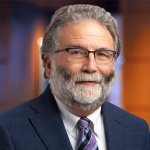
Exploring the Proposed Permanent Addition of Rule 12 to Supervised Practice Rules
By Jim Long, Maslon LLP
For the past three years the Minnesota court system has been operating under the temporary addition of Rule 12 to the Supervised Practice Rules. These amendments are part of a statewide pilot project (the Legal Paraprofessional Pilot Project) that allows approved Minnesota legal paraprofessionals to represent and advise clients in select housing and family matters.
The primary purpose of this pilot project was to increase access to civil legal representation in case types where one or both parties typically appear without legal representation. The project arose from the work of the Implementation Committee for the Legal Paraprofessional Pilot Project, which was established by the Supreme Court in 2019 to evaluate the delivery in areas of unmet civil legal needs. In accepting the recommendation of the Implementation Committee to establish the pilot project, Chief Justice Gildea wrote that, “the point of the pilot project was to test the assumptions that underlie our decision: that the need for civil legal aid, particularly in the areas of family law and landlord-tenants disputes is great, and that legal paraprofessionals can contribute to the needs of Minnesota citizens in these areas.” (September 29, 2020 Order)
New Rule 12.01 authorized eligible legal paraprofessionals, under the supervision of a member of the bar, to provide advice and appear in court: 1) on behalf of tenants in housing disputes under chapters 504B and 484.014 in district courts that have an established Housing Court or dedicated calendar for housing disputes, with the exclusion of Housing Court in the Fourth Judicial District; and 2) in family law cases, with a number of specific limits on the types of matters and proceedings.
The Supreme Court appointed a nine-member Standing Committee for Legal Paraprofessional Pilot Project. The chairperson of the Standing Committee was Gregory L. Richard, professor at Winona State University and director of its Legal Studies Program. Associate Justice Paul Thissen was the Minnesota Supreme Court liaison to the committee. The initial term of the Pilot Project was to be March 2021 through March 2023. The committee established several processes for the Pilot Project, including application, complaint, communication, and evaluation processes. In the committee's December 2021 Interim Report, it recommended that the Pilot program be extended another year, through March 2024. It also recommended expanding the scope of representation to include providing advice and representation to clients in family law matters when allegations of domestic abuse were made in the case and to include the ability for legal paraprofessionals to provide advice and representation in Order for Protection (OFP) and Harassment Restraining Order (HRO) cases. After receiving comments and holding a public hearing, the Supreme Court authorized the expanded scope.
We on the Standing Committee view the Legal Paraprofessional Pilot Program to be a success. In our final report on January 12, 2024, we recommended that the rule changes be made permanent, that the scope of allowed representation be expanded, and that a new committee be formed to administer the program going forward. The committee also recommends that the name of the program be changed to the Legal Practitioner Program to better clarify the role of the individual providing the representation and to utilize a title that translates better into Spanish. The report can be found at the LPPP webpage on the Judicial Branch website. To allow for the Supreme Court's consideration of the report and recommendations, the current Pilot has been extended to Aug. 31, 2024.
The application subcommittee approved 33 applicants. All legal paraprofessionals in the program had to be supervised by licensed attorneys who agreed to take on that role. Over the course of the Pilot Program those paraprofessionals handled 2,312 matters across 47 Minnesota counties. Fifty-eight percent of the reported matters were handled outside of court. Eighty-one percent of those cases were housing cases and 19% were family law cases.
The Standing Committee developed a formalized procedure and structure to handle complaints from clients concerning the legal paraprofessionals and/or their supervising attorneys. Despite having over 2,300 matters handled by legal paraprofessionals in the program, no complaints were submitted to the Standing Committee. Additionally, of the clients who responded to surveys by the Standing Committee, over 85% responded they were satisfied or very satisfied with the services they received, and the same percentage responded that they were likely or very likely to recommend the services of a legal paraprofessional to a friend. I view these data points as a testament to the quality of the representation by these legal paraprofessionals and to the efficacy of the program.
In my personal view, the strongest success of the program thus far has been achieved through its use by legal aid agencies across the state. Southern Minnesota Regional Legal Services (SMRLS) reported 1,267 closed cases and Justice North reported 781 closed cases. Legal aid providers expressed the following views:
“My office utilized the legal paraprofessional program, and my understanding is that it allowed us to serve more people and operate more efficiently with regard to housing matters.”
“We are a legal aid organization and it is helpful to have our LP… it is working out quite well so far.”
We all realize that the extent of the need for legal representation outpaces the ability of Minnesota’s excellent legal aid programs to meet the demand. Several of the legal aid providers have found that this program allows them to meet more client demand, and based upon that experience, have embraced the program. One of the recommendations made by the Standing Committee to the Supreme Court is to expand the program to include housing cases in the Fourth Judicial District. If accepted, that expansion should allow increased use of the program by the legal aid organizations in Hennepin County.
Based upon results of surveys conducted by the Standing Committee, the various individuals involved in the program—the legal paraprofessionals, the supervising attorneys, the clients, and the judicial officers—have all been positive and supportive of it. For example, of the responding supervising attorneys, 85% reported being “very satisfied” with the program, over 90% reported that they wished to continue in their role as supervising attorney, and all were in favor of making the program permanent. One supervising attorney wrote, “I do think the scope needs to be analyzed and potentially broadened. A highly experienced paralegal can, frankly, do quite a lot of work in the family law realm competently.”
Among the comments from legal paraprofessionals surveyed was one that pointed directly to the program's impact on those in need: "Legal Services was able to assist more clients at eviction hearings with my assistance," the paraprofessional wrote. "We are at an all-time high in the Judicial District with eviction/housing cases." All the legal paraprofessionals responding to the survey said they would continue to be involved in their role if the amendments were made permanent.
The Standing Committee has recommended to the Supreme Court that the current practice areas be retained and that the scope of allowable representation be expanded into a number of categories. These categories include: 1) expand to Housing Court in the Fourth Judicial District; 2) expand to advice and representation in criminal expungement case; 3) provide advice in and appear in certain conciliation court matters on behalf of debtors, as well as more generally in consumer debt and student loan cases up to a value of $15,000; 4) provide advice and representation to clients in petty misdemeanor cases; 5) provide advice and representation in certain limited estate administration and probate cases; 6) provide advice and representation in certain Office of Administrative Hearing cases; and 7) provide advice and representation in denial of benefits cases for benefits administered by the Department of Human Services.
These recommendations to expand categories were based upon investigation of each area by members of the committee and by reaching out for input from relevant stakeholders. These recommendations resulted from the experience of the program that demonstrated the ability of legal paraprofessionals to handle a wider variety of areas and the demonstrated competence of those paraprofessionals. The intent of these expansions is to increase access to justice for individuals who would otherwise be unable to obtain legal representation.
The Supreme Court has opened a public comment period on the recommendations of the Standing Committee that is open through April 8, 2024. It has set a public hearing for June 13, 2024. To learn more about the program and read the full report, visit mncourts.gov/lppp.

Jim Long of Maslon LLP in Minneapolis has over 35 years' experience trying cases and counseling businesses in the areas of antitrust law, franchise law, and dealer/distribution law. He is also a dedicated pro bono attorney, having been recognized as a North Star Lawyer by the MSBA every year since the program began. Jim has served on the Minnesota Supreme Court's Legal Services Advisory Committee since 2021 and its Legal Paraprofessional Pilot Project Standing Committee since the committee's inception.